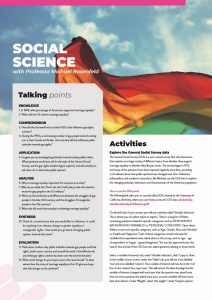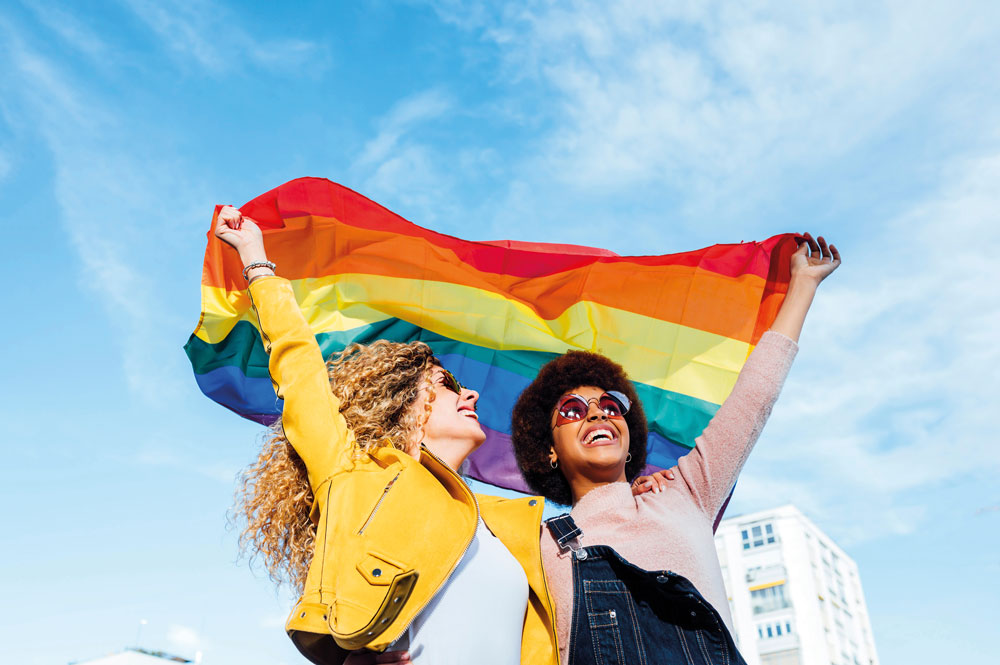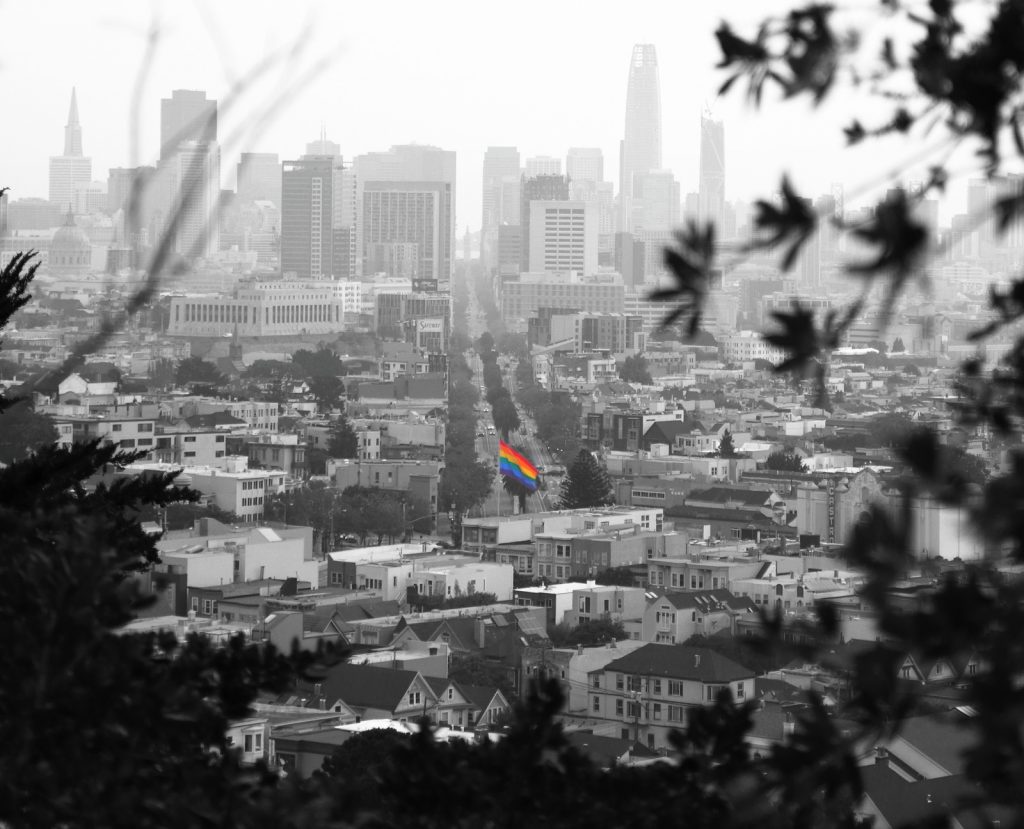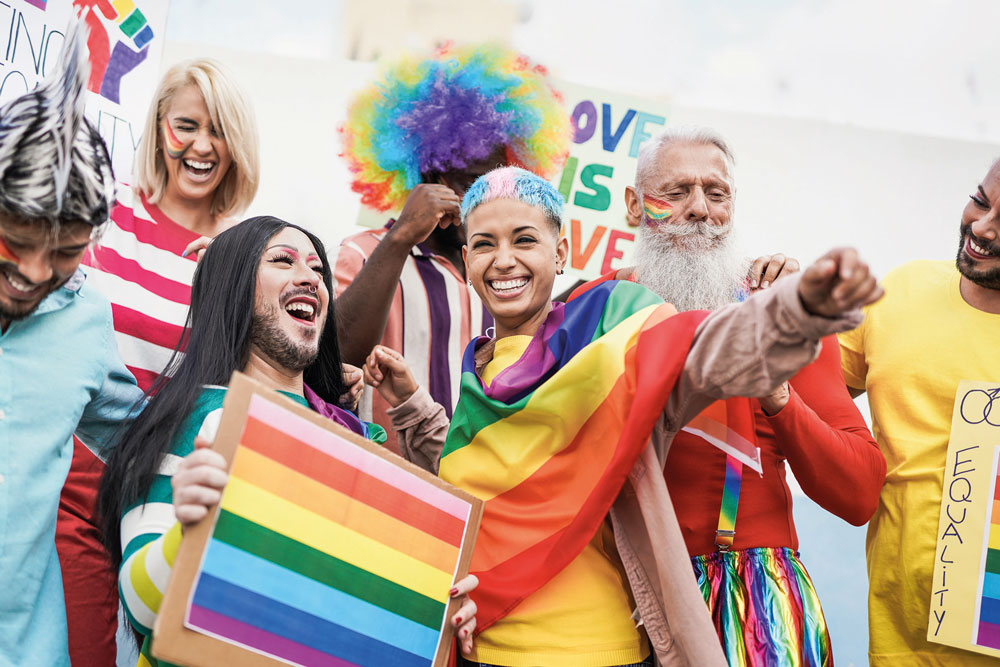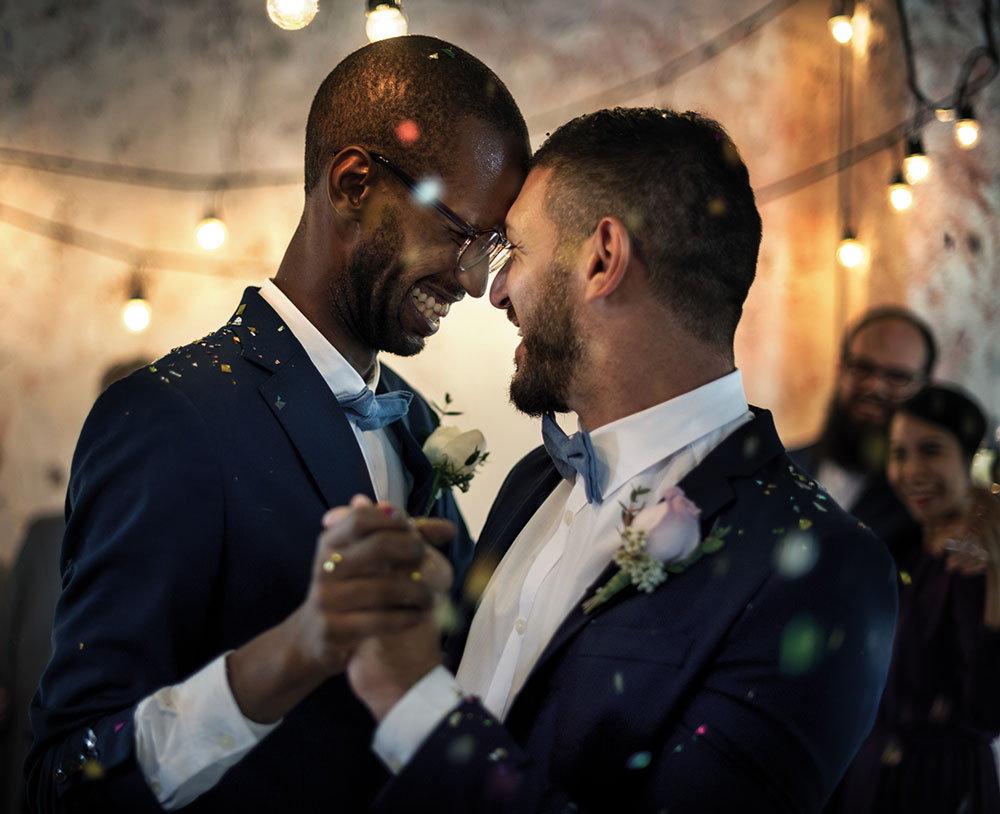Social science for social change: the story of marriage equality in the US
For centuries, gay people have suffered discrimination, prejudice and persecution. However, since the 1990s, public attitudes towards gay rights in the US have undergone a monumental shift. Professor Michael Rosenfeld, a sociologist at Stanford University, has studied this dramatic change in public opinion. Not only has Michael investigated why it occurred, he also played an important role in achieving marriage equality in the US.
TALK LIKE A SOCIAL SCIENTIST
AIDS (acquired immunodeficiency syndrome) — an infectious disease caused when the human immunodeficiency virus (HIV) weakens a person’s immune system
Discrimination — treating people differently based on certain characteristics, such as their gender, sexuality or race
Gay — a person attracted to someone of the same sex. In this article, the term is used to refer to both men and women
Marriage equality — when same-sex couples have the same right to marry as different-sex couples
Public opinion — the collective opinion on a particular topic
Social change — changes to how a society behaves
Sue — to take legal action against a person or organisation
Supreme Court — the highest court in the US that has the ultimate say on legal matters at a national level
In 2015, the Supreme Court legalised same-sex marriage in the US, giving same-sex couples the same right to marry as different-sex couples. This landmark ruling was the result of the tireless work of gay rights activists over several decades, who campaigned for marriage equality to be enshrined in US law.
In 1988, less than 30 years earlier, only 12% of Americans supported the idea of marriage equality (while 88% opposed it or had no opinion) and 77% believed that gay sex was always wrong (while 23% believed it was not always wrong). Yet, in just a few short decades, these attitudes had dramatically changed. By 2016, 59% of Americans thought same-sex couples should have the right to marry and the proportion of the population opposed to gay sex had decreased to 40%. According to Professor Michael Rosenfeld, a sociologist at Stanford University, “This is the story of the greatest transformation of public opinion in US history.”
Most public attitudes remain relatively stable over time and social change is a slow process. The fight for racial equality, for example, began centuries ago and is still in progress. As social change goes, the shift in public opinion about marriage equality was unprecedented. So, why did public attitudes to gay rights change so significantly?
The recent history of gay rights in the US
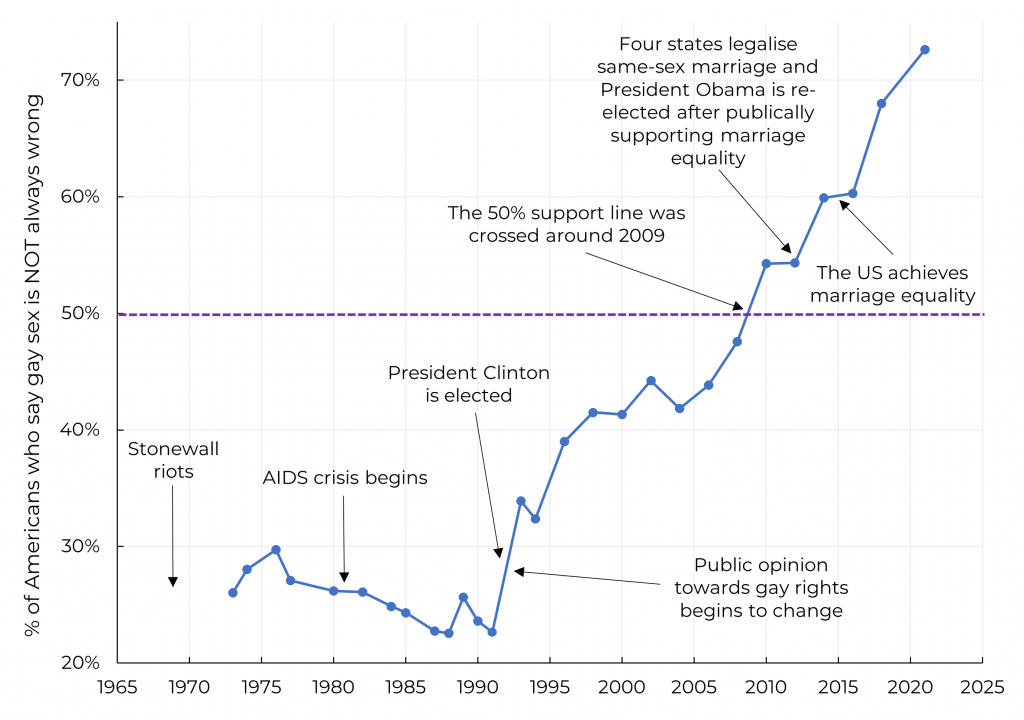
This figure is derived from General Social Survey data. Respondents were asked ‘What is your opinion about sexual relations between two adults of the same sex?’ Answer options were ‘Always wrong’, ‘Almost always wrong’, ‘Sometimes wrong’ and ‘Not wrong at all’. This question was first asked in 1973, when gay rights were almost universally opposed in the US, hence the anti-gay emphasis in the answer options.
1969: the Stonewall riots
From the outside, the Stonewall Inn did not look very impressive. Its drab exterior disguised it as just another New York bar. The inside was dark and dingy, the air hot, stuffy and reeking of stale cigarette smoke. The bar had no running water. But, if you pushed through a set of double doors at the back of the bar, you could enter a world of dance music and rainbow colours. The Stonewall Inn was one of the few places in New York City where gay people felt safe and accepted. The danceroom behind the bar was a haven for people to dance with same-sex partners, dress in drag and express themselves freely, without judgement or hostility.
Reference
https://doi.org/10.33424/FUTURUM385
© Jose Luis Carrascosa / Shutterstock.com
In June 1969, police raided the Stonewall Inn, as the discriminatory laws of the time meant gay bars were illegal. This raid sparked three nights of violent rioting throughout the neighbourhood, acting as a catalyst for the gay community to fight against oppression. “The Stonewall riots became a rallying cry for gay rights activists to organise politically and fight back against police harassment,” explains Michael. Now, every June in cities all over the world, people march and celebrate Gay Pride in commemoration of the 1969 Stonewall riots.
1980s: the AIDS crisis
AIDS is a serious viral disease that was first recognised in 1981. Before effective treatments were developed, the death toll from AIDS was severe, and it particularly affected gay men. The US government initially ignored the problem, so gay men had to find ways of supporting each other. They set up support groups to care for those suffering from AIDS and created organisations that campaigned for increased AIDS awareness.
The activism born from the Stonewall riots and AIDS crisis could only be organised when gay people declared their sexuality; they had to ‘come out’ and let other people know they were gay. “Coming out to friends and family turned out to be a very effective way to influence other people to support gay rights,” explains Michael.
1990s: public opinion begins to change
During his presidential campaign in 1992, Bill Clinton said he wanted to lift the ban on gay people serving in the US military. Before this, no presidential candidate had ever said anything positive about gay rights. “Words matter!” says Michael. “The President of the United States is the most powerful person in the country, so the president’s words matter even more.” Unfortunately, Clinton’s ambitions never came to fruition. In the early 1990s, public and political opinion was still against gay rights, and he was instead forced by Congress to implement a ‘Don’t ask, don’t tell’ policy, which made the situation even worse for gay people in the US military by making them hide their sexual identities. As a result, Clinton is often vilified by gay rights activists. “However, he started the public and political conversation about gay rights,” says Michael.
Public acceptance of gay people and support for gay rights began to rise rapidly after 1992. This was primarily due to the increase in people coming out as gay. For a long time, gay people had been forced to live in secrecy, so most straight Americans thought they had never met a gay person before. “Once straight people knew there were gay people in their family and friendship circles, they realised there was no reason to fear them as gay people were just like themselves,” explains Michael. “We tend to trust and respect the people we are closest to (our friends, families, school mates and colleagues), so knowing gay people meant that respect for gay rights rapidly increased.”
The 21st century: marriage equality is achieved
As acceptance grew, so did the hopes of achieving marriage equality. By 2010, support for gay rights had crossed over the 50% threshold. Now, with the majority of the population onside, it was easier for gay rights to win in court cases and elections. In 2012, four US states legalised same-sex marriage and President Barack Obama made a statement in support of marriage equality. Later that year, he was re-elected, indicating the majority of voters were in favour of marriage equality.
Over the next few years, many same-sex couples living in states that still did not recognise same-sex marriage sued their state for the right to marry. Then, in 2015, a ruling by the Supreme Court made same-sex marriage legal in all 50 US states, finally achieving marriage equality.
Today, gay rights activists are still fighting to ensure that gay people in the US and across the world can live their lives free from discrimination, prejudice and persecution. However, in less than three decades, the memory of the Stonewall riots, the gay community’s response to the AIDS crisis and the bravery of millions of gay people who have come out over the ensuing years have helped change the attitude of an entire nation. “Social change happens slowly, so you don’t notice it from one day to the next,” says Michael. “You can’t change opinions overnight, but it is important to know that, over the years, you can change the world.”
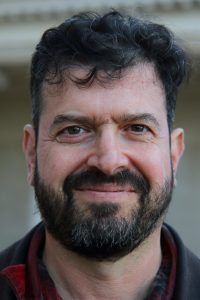 Professor Michael Rosenfeld
Professor Michael Rosenfeld
Department of Sociology, Stanford University, USA
Field of research: Sociology
Research project: Investigating changing attitudes towards marriage equality in the US
Social science for social change
Societies and the social networks that exist within them can be incredibly complex. With so many interrelated parts, trying to understand how they interact can be a difficult task. To understand how public opinions and attitudes have changed over time, Michael analyses data from the US General Social Survey (GSS) and the US census. The GSS is a semi-annual survey that asks Americans their opinion on a huge variety of different topics, from whether they support marriage equality to whether they like jazz music. In addition to his data analysis, Michael also reads books on relevant topics, studies history, interviews people who sued their states for the right to marry and learns about the US legal system.
How did social science influence the fight for marriage equality?
In 2010, Michael published an academic paper showing that children who were raised by same-sex couples performed just as well at school as those raised by different-sex couples. “Most academic papers are only read by the handful of other academics interested in the same research topic,” says Michael. “I didn’t expect my paper to have any public impact.” Little did he know that his seemingly insignificant contribution to academia would advance the cause of marriage equality.
In 2012, April DeBoer and Jayne Rowse sued the state of Michigan for the right to marry, leading to a trial in a federal courtroom in 2014. Some anti-gay rights scholars had disputed the findings of Michael’s 2010 research paper, and Michigan’s lawyers called them as witnesses for the case against April and Jayne. In response, April and Jayne’s lawyers called Michael as a witness for their side of the argument. “I was delighted to oblige!” he says.
As an ‘expert witness’, Michael’s role in court was to explain his social science research to the judge and highlight why the opponents’ arguments were misleading. While public opinion can be influenced by personal prejudices, there is no space for dogma or prejudice in the court room. Instead, trials are based on objective truth, facts and the law.
In proving that children fared no differently at school, regardless of the sex of their parents, Michael used social science as evidence that April and Jayne should be allowed to marry. As a result, the judge ruled in April and Jayne’s favour. The state of Michigan appealed the judge’s decision, so, along with three similar cases of same-sex couples suing their states, the case was passed on to the Supreme Court. In 2015, the Supreme Court agreed that all four same-sex couples had the right to marry, and marriage equality was made the law across the whole country. “Most social science does not change policy right away,” says Michael. “I was lucky to have the opportunity to make a real difference in a case that turned out to have national significance.”
Why is marriage equality important for everyone?
The right to marry the person you love is a basic adult human right. Therefore, marriage equality is important for everyone in society, regardless of sexuality and whether or not they have a desire to get married. “When same-sex couples were denied the right to marry, it symbolised a second-class status and encouraged discrimination against them,” explains Michael. “While this discrimination has not gone away, it has lessened.”
Why should we be encouraged by the story of marriage equality?
For a long time, marriage equality was so unpopular in public opinion that even gay rights activists thought it could never be achieved. And yet, in just a few decades, it became law across the country. The story of marriage equality teaches us that social change is possible, no matter how impossible it may seem. “It takes a long time to make social change,” says Michael. “The fight for gay rights endured decades of losses and setbacks before they started to win. So, try not to be discouraged by setbacks in the changes you hope to see.”
There are many issues on which the youth and older generations disagree. For young people, it can seem as though adults hold all the power. “But remember, by the time you are 30 or 40, many of the people who oppose your views will be retired,” says Michael. This will leave room for a new generation of more tolerant public figures.
How can you initiate social change?
As soon as you are eligible, ensure you vote to make your voice heard. And you can start initiating change now, whatever your age. Get involved with issues you care about. Learn how to be persuasive about your views but also respectful to those who disagree with you. Don’t let their opinions discourage you; with time, they may come round to your way of thinking. In the same way that gay people changed the opinions of their families and friends, leading to a dramatic change in public opinion towards gay rights in the 1990s, remember that you can influence the people around you. As Michael says, “You have more power than you know.”
Pathway from school to sociology
• “If you care about the world and are interested in both people and data, then sociology is a great field to study!” says Michael.
• There is a lot of overlap between the social sciences: sociology, psychology, economics, anthropology and political science, as well as history and law. Knowledge from all these fields will be useful if you are interested in sociology, so a degree in any of these subjects could lead to a career in sociology.
• Sociology research often relies on applied statistics and data manipulation, so a solid understanding of mathematics is also useful.
• Find social science books and articles that address aspects of the world that interest you. Be curious and learn about the things you are passionate about. For examples, Contexts is an online magazine about sociology and social science research, full of interesting articles written for a general audience: www.contexts.org
• Michael’s website contains free versions of his published academic papers, resources for the sociology classes he teaches and information about the court case he participated in: www.web.stanford.edu/~mrosenfe
Explore careers in sociology
• Studying sociology will open many career possibilities, such as teaching, social work, marketing, public relations and law. “A lot of sociologists work for big internet companies, as these companies are built on the sociological theory of social networking,” says Michael.
• Prospects provides information about the range of careers available for people with a sociology degree: www.prospects.ac.uk/careers-advice/what-can-i-do-with-my-degree/sociology
Do you have a question for Michael?
Write it in the comments box below and Michael will get back to you. (Remember, researchers are very busy people, so you may have to wait a few days.)


